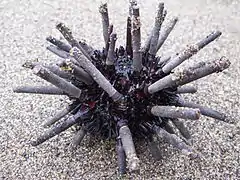Eucidaris galapagensis
Eucidaris galapagensis is a species of cidaroid sea urchin that inhabits littoral regions of the Galápagos, Clipperton, and Cocos.[1][2][3] It used to belong to the subspecies E. thouarsii to the slate pencil urchin, but is now recognized as its own species separated by the aforementioned regions.[3]
| Eucidaris galapagensis | |
|---|---|
 | |
| Galapagos sea urchin (Eucidaris galapagensis) in the Galapagos | |
| Scientific classification | |
| Kingdom: | |
| Phylum: | |
| Class: | |
| Order: | |
| Family: | |
| Genus: | |
| Species: | E. galapagensis |
| Binomial name | |
| Eucidaris galapagensis | |
Diet
Like all urchins these are primarily herbivores, but feed on a wide range of invertebrates.[4] This species has a high nutrient absorption efficiency when it comes to the coral Pocillopora damicornis, but would require a large intake to make nutrient requirements.[5] Due to its high intake of coral, it reduces reef growth within the Galapagos.[6]
References
- Encyclopedia of Life. "Details for: Eucidaris thouarsii". Encyclopedia of Life. Retrieved 2013-07-23.
- Kroh, A.; Mooi, R. "Details for: Eucidaris thouarsii". World Echinoidea Database. Retrieved 2013-07-23.
- Lessios, Kessing, Robertson, and Paulay (1999). Phylogeography of the pantropical sea urchin Eucidaris in relation to land barriers and ocean currents. Evolution 53: 806-817.
- Baumiller, Tomasz K. (2008). "Crinoid Ecological Morphology". Annual Review of Earth and Planetary Sciences. 36: 221–49. Bibcode:2008AREPS..36..221B. doi:10.1146/annurev.earth.36.031207.124116.
- Lawrence, John M.; Glynn, Peter W. (1984-01-01). "Absorption of nutrients from the coral Pocillopora damicornis (L.) by the echinoid Eucidaris thouarsii (val.)". Comparative Biochemistry and Physiology -- Part A: Physiology. 77 (1): 111–112. doi:10.1016/0300-9629(84)90020-3. ISSN 0300-9629.
- Glynn, Peter W.; Wellington, Gerard M.; Birkeland, Charles (1979-01-05). "Coral Reef Growth in the Galápagos: Limitation by Sea Urchins". Science. 203 (4375): 47–49. Bibcode:1979Sci...203...47G. doi:10.1126/science.203.4375.47. ISSN 0036-8075. PMID 17840510.
This article is issued from Wikipedia. The text is licensed under Creative Commons - Attribution - Sharealike. Additional terms may apply for the media files.